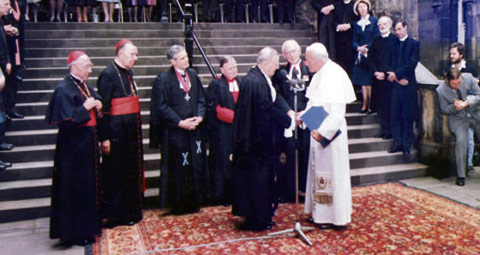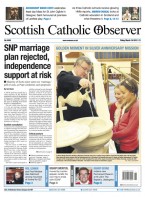August 20 2010 | ![]() 0 COMMENTS
0 COMMENTS ![]() print
print

A perfect visit that drove out any fears
Publication Date: 2010-08-20
Author MICHAEL TURNBULL, gives an account of how Pope John Paul II overcame difficulties that threatened his visit to Scotland in 1982 to make it a truly memorable occasion for all
MEMORY plays strange tricks but the visit of Pope John Paul II to post-Reformation Scotland in 1982 was complex to plan and fraught with multiple difficulties. Although the future Popes Pius II and Paul VI had travelled to Scotland in 1435 and in the 1930s (both on confidential missions), this was to be the first visit of a serving Pope to the country.
When the Falklands Conflict broke out in April 1982 it cast serious doubts on the possibility of a Papal visit to Britain and Ireland. Pope John Paul asked the two Argentinian Cardinals—Raul Primatesta and Juan Aramburu, to come to Rome for discussions and the friendship which Bishop Stephen McGill and Cardinal Gordon Joseph Gray, leader of Scotland’s 837,000 Catholics, had developed with the Argentinian Bishops at the Second Vatican Council proved providential.
The first meeting with the Argentinian Bishops was to be at a working lunch. Cardinal Basil Hume and Cardinal Gray were waiting in an anteroom to the Papal apartments when they arrived.
“Shall I ever forget.” Cardinal Gray said. “Cardinal Aramburu entered the room. His eyes opened wide when he saw me and he came straight to me, embraced me and kept repeating “Bene, bene—Gordon!” Cardinal Gray felt Vatican II was still bearing its fruit. “A little bonus that helped us in 1982,” he later recalled.
There was also some unpleasantness at home. Three telegrams protesting at the Pope’s visit were sent to Queen Elizabeth II, Prince Charles and the Prime Minister, Margaret Thatcher on behalf of the Religion and Morals committee of the Free Presbyterian Church of Scotland, by the Revd John Macleod of Stornoway, clerk of the committee. Thankfully, negotiations over the visit resulted in a positive outcome.
Touching down in Edinburgh
Forty minutes late, at 5.25pm, the British Caledonian BAC 111 plane carrying Pope John Paul II touched down at RAF Turnhouse in Edinburgh. Upon descending from the plane, the Pope went over to the grass verge, bent down and reverently kissed the soil of Scotland—the filia specialis (special daughter of the Holy See), so called from the Papal Bull of Pope Honorius in 1216, a major turning-point in the history of the medieval church as it asserted Scotland’s independence from the jurisdiction of the Archbishop of York.
The cardinal introduced the Pope to Tom Morgan, Lord Provost of Edinburgh, to Archbishop Thomas Winning and the eleven Scottish Bishops, all of whom were wearing security-classified identification badges with colour photos on their chests. George Younger, Secretary of State for Scotland and Air Vice-Marshal Tim Lloyd, Air Officer Scotland and Northern Ireland, were withdrawn at the last minute. The servicemen in the crowd were not wearing uniforms.
The Pope left Turnhouse, travelling by road through west Edinburgh to Murrayfield Stadium where 44,000 ecstatic young Scots heard him say: “Young people of Scotland, I love you.” Enormous shouts of joy interrupted his address with cheering on more than 30 occasions. ‘John Paul, John Paul’ they called out, then singing ‘He’s got the whole world in his hands, You’ll never walk alone and Flower
of Scotland.’
Around 6.50pm he was driven from Murrayfield to St Mary’s Metropolitan Cathedral. Halfway along Princes Street he took a turn up the Mound to the home of the General Assembly of the Church of Scotland. Two hundred demonstrators led by Rev Ian Paisley protested in front of the Assembly Hall but were prevented by police from breaking through barriers. Crowds on the Mound drowned out the jeers from the placard-waving demonstrators. Below the steps of the Assembly Hall, outside Edinburgh University’s New College and in the shadow of the stern statue of the Papal notary and Reformer, John Knox in the dramatic act of preaching, he was greeted by the Moderator, the Right Rev Professor John McIntyre and by nine former moderators and their wives.
Spirit of reconciliation
Professor McIntyre told the Pope that the history of Scotland was scarred by many occasions of religious conflict and
controversy.
“From the spirit of reconciliation which informs our meeting today we, for our part, look forward to further dialogue with your Church not only on subjects of disagreement but also on the joint themes on which we agree in the face of a hostile world,” he said.
Among the people presented to the Pope was Professor James Mackey of the Thomas Chalmers Chair of Systematic Theology at New College and himself a former Catholic priest. Later, at St Mary’s Cathedral he addressed 1000 priests, nuns and monks—cheering and waving Papal flags.
Early on the Tuesday morning, leaders of Scotland’s other denominations, including Professor McIntyre, Jewish and Islamic leaders, met at St Bennet’s to join the Pope for discussions. The Pope spoke of working together for the promotion of human values and his desire for full unity between churches. He said that the will for unity was a sign of hope to a divided world. During the meeting, the moderator and the Pope exchanged gifts of a silver quaich and a silver statuette of the Good Shepherd.
At a press conference Professor Macintyre, who planned to pay a courtesy visit to the Pope the following spring, praised John Paul as a man of peace and reconciliation who had redrawn the character of the Papacy.
“We are looking to this meeting with a sense of expectation, that as a result the dialogue between Catholics and Protestants will be furthered,” Professor McIntyre said.
Responding to misgivings and protests over the meeting, he added: “I understand why people are unhappy about this meeting. They are understandably afraid that the things for which the martyr dies should be lost. But nobody has ceded an inch on these basic points so far.”
Glasgow greetings
For Pope John Paul, Tuesday began with a visit to St Joseph’s Hospital, Rosewell and, the culmination of his visit —Mass at a euphoric Bellahouston Park in Glasgow on June 1, 1982 with 300,000 worshippers and well-wishers, bathed in sublime sunlight.
I was privileged to have been a member of the official Papal Choir and I remember that day as a little glimpse of Heaven. We were bussed through from Edinburgh early that morning and the groups which had rehearsed separately in every Scottish diocese met together for the first time at Bellahouston where we were assembled on a hastily-erected raked stand, all 850 of us grouped into our voices.
Down in front of us was the Croy Silver Band; up behind was the Battlefield Band and young string-players; also in front stood choir-director George Farmer, musician and former RAF fighter-controller and our organist. Each of us had our music and security-badge and the souvenir of the Papal Mass booklet, edited by the late Fr John Fitzsimmons, who also wrote the homily which the Pope delivered that day, including the invitation to other Christians to walk ‘hand in hand’ with him. The responsorial psalm was sung by the Scottish Opera soprano, Josephine MacQueen and there was a Papal piper, resplendent in tartan.
During the Mass we were too busy singing and participating to notice anything but the crowds stretching as far as the eye could see. The highlight was the hymn Our God Reigns, accompanied by the silver band and the strings. The Pope had come down from the sky and, when the time came for him to leave, he passed in front of us and we raised our arms and waved frantically. Then he took to the skies again.
Cheering crowds
Back in Edinburgh, Cardinal Gray recalled that: “When we made our way from the helipad at Holyroodhouse into the Popemobile after the Holy Father’s glorious reception at Bellahouston, the streets were thick with cheering crowds.”
Along the Queen’s Park to Salisbury he passed, then into Grange Road towards the cardinal’s home. On both sides, flags, handkerchiefs, umbrellas, hats, waving in the glorious sunset. Smiling police, joyful on-lookers, all happiness and a truly Scottish welcome. And the smiling Holy Father, blessing to left and right as we made our way slowly to the temporary railings erected for the Papal visit and closing off the roads that passed St Bennet’s.’
“We instructed the driver to turn the Popemobile so that His Holiness could speak to the ever-gathering crowds of 15-20,000, who massed outside our temporary enclosure in the park,” the cardinal said.
On arrival at St Bennet’s we were met by a cheering crowd of some 3000 people. Archbishop Marcinkus and Police Superintendant MacPherson had anticipated just such a reception. One of them handed the Holy Father a loud-hailer. He spoke to the crowd for just a couple of minutes. He thanked them for the reception they had given him, the love they had shown; told them they must be tired after waiting so long. Then he blessed them in Latin and wished them goodnight. “I wish you one thing, it is a good sleep.’” he said. As he went into St Bennet’s the Pope summed up the day: “It was wonderful.” The cheers went on for a long, long time, as the sun sank gently in a golden red sunset.
The crowds did not disperse. Hundreds of young folk camped out in sleeping-bags all night, so as to have a last glimpse of John Paul II when he passed by in the morning, headed for Turnhouse Airport. Cardinal Gray thought back to how different it was to the hate-filled anti-Catholic demonstrations that had convulsed that part of Edinburgh in June 1935.
“Christian Unity,” he commented, “may still be far away but the winds of change have been gently blowing and in my 34 years as a bishop I have seen the mists slowly clearing and our mutual interdenominational and inter-Church suspicions gradually give way to an acknowledgement of sincerity in those with whose religious beliefs and theological teaching we cannot agree with nor accept.
“Hatred now has given way to love—‘There is no fear in love,’ said St John. ‘Perfect love drives out all fear.’”
— Michael T R B Turnbull is the author of Cardinal Gordon Joseph Gray (Saint Andrew Press, 1994)










